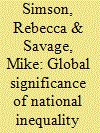|
|
|
Sort Order |
|
|
|
Items / Page
|
|
|
|
|
|
|
| Srl | Item |
| 1 |
ID:
169772


|
|
|
|
|
| Summary/Abstract |
The unfair distribution of public sector jobs is a common grievance in many societies, but arguably more so in ethnically polarized ones. Using census data from Kenya and Uganda, two countries with a history of ethnic conflict, this article examines how public employment is allocated in multi-ethnic societies by studying the correlates of holding public sector jobs. The results demonstrate that the public services of Kenya and Uganda are first and foremost comprised of educational elites with considerably higher average levels of educational attainment than across the labour forces at large. However, when education is controlled for, high-skilled women and candidates from less developed districts are more likely to work for the state than others. As a result, public sector jobs are more equitably distributed along gender, regional and ethnic lines than education alone would predict. I hypothesize that formal policies to promote regional equity in the provision of basic services in combination with affirmative action measures are contributing to creating comparatively inclusive public services.
|
|
|
|
|
|
|
|
|
|
|
|
|
|
|
|
| 2 |
ID:
176491


|
|
|
|
|
| Summary/Abstract |
Does a leader's ethnicity affect the regional distribution of basic services such as education in Africa? Several influential studies have argued in the affirmative, by using educational attainment levels to show that children who share the ethnicity of the president during their school-aged years have higher attainment than their peers. In this paper we revisit this empirical evidence and show that it rests on problematic assumptions. Some models commonly used to test for favouritism do not take adequate account of educational convergence and once this is properly accounted for the results are found to be unstable. Using Kenya as a test case, we argue that there is no conclusive evidence of ethnic favouritism in primary or secondary education, but rather a process of educational convergence among the country's larger ethnic groups. This evidence matters, as it shapes how we understand the ethnic calculus of politicians.
|
|
|
|
|
|
|
|
|
|
|
|
|
|
|
|
| 3 |
ID:
173904


|
|
|
|
|
| Summary/Abstract |
Since the 1980s, inequality has been rising in Europe, North America and parts of Asia. How does our understanding of global inequality dynamics change if coverage is extended to the rest of the developing world? To rebalance the perspective on global inequality trends, this paper surveys data and literature on recent inequality trends in Latin America, Asia, Africa and the Middle East. It finds that in these regions there are more countries with falling than rising inequality over the past 20 years, as measured by Ginis of income or consumption inequality. At the global level, therefore, there are signs of inequality convergence, as inequality has been falling in countries with high inequality in the 1990s (particularly Latin America), and rising in historically low-inequality countries. We discuss the political and economic drivers of inequality decline in countries with a steady fall in the Gini. This suggests some common trends across the globe, including the role of democratisation, the rise of new social movements, and the expansion of education and social safety nets and favourable commodity prices, in reducing income disparities. This paper calls for more country-level comparisons of inequality trends, to highlight the multiplicity of paths in this latest phase of globalisation.
|
|
|
|
|
|
|
|
|
|
|
|
|
|
|
|
|
|
|
|
|